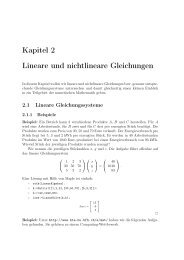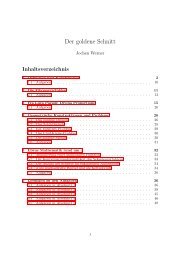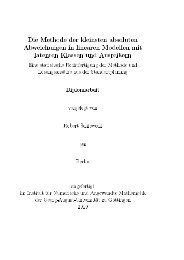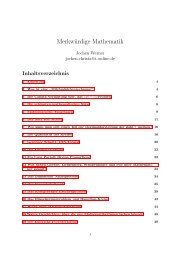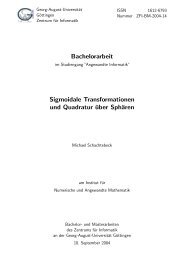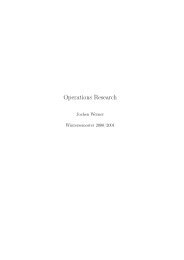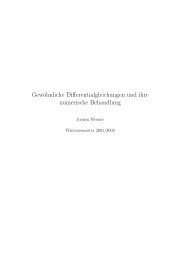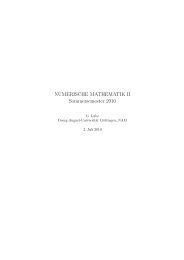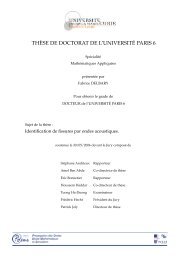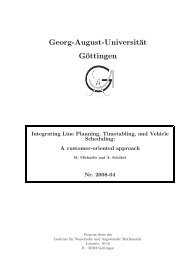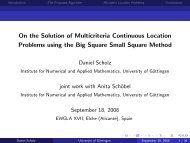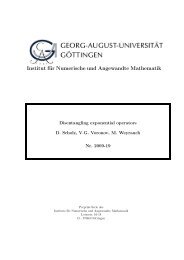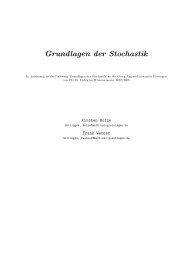BAIL 2006 Book of Abstracts - Institut für Numerische und ...
BAIL 2006 Book of Abstracts - Institut für Numerische und ...
BAIL 2006 Book of Abstracts - Institut für Numerische und ...
Create successful ePaper yourself
Turn your PDF publications into a flip-book with our unique Google optimized e-Paper software.
H. WANG: A Component-Based Eulerian-Lagrangian Formulation for Compositional<br />
Flow in Porous Media<br />
✬<br />
✫<br />
Figure 1: The ELLAM ((a)-(b)) and upwind ((c)-(d)) simulation at 5 and 20 years.<br />
(a) The overall mole fraction <strong>of</strong> Methane (b) The molar amount <strong>of</strong> Methane in vapor<br />
(c) The overall mole fraction <strong>of</strong> Methane (d) The molar amount <strong>of</strong> Methane in vapor<br />
Discussion The numerical results show that the Eulerian-Lagrangian formulation generates<br />
stable and accurate solutions (overall mole fractions) that have preserved physically reasonable<br />
moving steep fronts, even if a large time step <strong>of</strong> ∆tel = 1 year is used. With the (largest<br />
possible) fine time step ∆tup = 2 days, the upwind method generates qualitatively similar (but<br />
much more diffusive) overall mole fraction. We observe a similar comparison in terms <strong>of</strong> the<br />
normalized molar amounts in the vapor and liquid phases.<br />
It is instructive to look at the computational efficiency. Although the Eulerian-Lagrangian<br />
method uses more CPU time than the upwind method in solving the mass balance equations,<br />
both simulators have to perform the same computations on the pressure system and the thermodynamic<br />
flash calculations which consume a larger portion <strong>of</strong> the CPU time per iterative step<br />
at each time step. These results indicate that the Eulerian-Lagrangian simulator uses less than<br />
twice the CPU time an upwind simulator uses per time step. Therefore, the Eulerian-Lagrangian<br />
method generates accurate and stable solutions with steeper fronts using much less CPU time.<br />
References<br />
[1] H. Aziz and A. Settari, Petroleum Reservoir Simulation, Applied Science Publishers, 1979.<br />
[2] M.S. Espedal and R.E. Ewing, Characteristic Petrov-Galerkin sub-domain methods for twophase<br />
immiscible flow, Comput. Meth. Appl. Mech. Engrg., 64, (1987) 113–135.<br />
[3] R.E. Ewing, T.F. Russell, and M.F. Wheeler, Simulation <strong>of</strong> miscible displacement using<br />
mixed methods and a modified method <strong>of</strong> characteristics, SPE 12241, (1983), 71–81.<br />
[4] R. Helmig, Multiphase Flow and Transport Processes in the Subsurface, Springer Verlag,<br />
Berlin, 1997.<br />
[5] H. Wang, D. Liang, R.E. Ewing, S.L. Lyons, and G. Qin, An ELLAM-MFEM solution<br />
technique for compressible fluid flows in porous media with point sources and sinks, J. Comput.<br />
Phys., 159, (2000) 344–376.<br />
Speaker: WANG, H. 20 <strong>BAIL</strong> <strong>2006</strong><br />
✩<br />
✪



